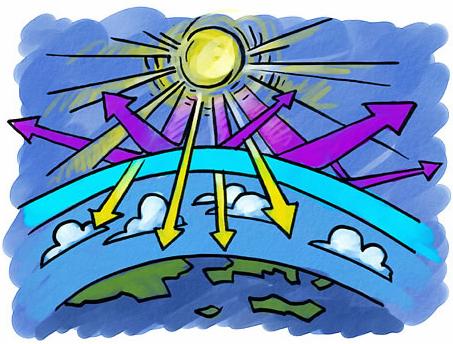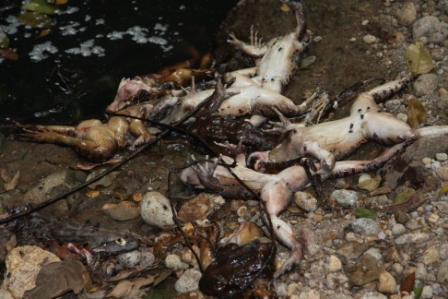
| Sticking It to the Ozone Layer By Michelle Mairesse |

| Sticking It to the Ozone Layer By Michelle Mairesse |
Once I lived in a vine-covered house in Los Angeles County. Back of the house, off the patio, a small creek ran--swollen and muddy in winter, lazy and green in summer. On starry summer nights, I sat under the jacaranda tree and listened to a frog concert from the creek. The choristers croaked and chirped in tones ranging from bullfrog basso profondo to leopard frog treble. I doubt that today there are many frog concerts in Los Angeles County, and I know that stars are rarely visible. The creeks crawl through concrete. Smoggy skies block the starlight. It's obvious that wetland destruction means death to wildlife, but now all life, wild and tame alike, faces an insidious danger. The story begins a few decades ago. We'll call it "The Case of the Disappearing Frogs and Toads." All over the world, bewildered scientists reported that aquatic toad and frog populations were disappearing from wetlands habitats. Scarcely any could be found in ditches, ponds, and creeks. Even in remote lakes far from industrial insult, the once plentiful amphibians were dying out. What could be wrong?

Now we know. Oregon State University biologists carried out a convincing experiment on toad eggs spawned in a mountain lake. After observing that not a single toad egg hatched, the biologists removed eggs to the laboratory and shielded them from sunlight. Under these laboratory conditions, the eggs developed into toads. After more trials, the researchers concluded that toad and frog eggs are being bombarded by long wave ultraviolet rays (UVB) from the sun. These rays are invisible, but anyone whose skin has been seared by sunburn has felt their power. Fortunately for life on earth, ozone gas that forms above the atmosphere shields us from this radiation. We were complacent about our ozone shield until 1974, when two researchers from the University of California at Irvine published the results of their experiments: Tons of chlorofluorocarbon, called CFC for short, drift up from earth into the atmosphere. There, the CFC is broken into its constituents by ultraviolet rays. As soon as chlorine atoms are released from CFC compounds, they attack ozone molecules at a ferocious rate.

The study noted that we were manufacturing these CFCs right here on earth. They kept us warm and cool in the form of refrigerants and insulators. In the form of foam sheets and pellets, they protected everything from apples to zippers during shipping. Our homes were full of them, as shoe soles, upholstery, bedding, and aerosol sprays. Industry employed them as solvents. However useful they might be, though, CFCs devour the ozone layer. The Irvine study created a temporary commotion, but soon the world was back to business as usual. Chemical industries said the study required more study. Americans voluntarily cut their use of aerosol sprays by half and thought the problem was solved. It wasn't. Ten years later, a NASA satellite detected an enormous hole in the ozone shield above Antarctica. Once again, the alarmed public demanded that somebody do something. Then Secretary of the Interior Donald Hodel said, No problem. Hats, sunscreens, and sunglasses would be ample protection against ultraviolet rays. Donald didn't get very far with that one. Cartoonists had a field day portraying herds and domestic animals tricked out in hats and sunglasses. The Environmental Protection Agency predicted millions of fatal skin cancer cases resulting from ozone layer depletion. In 1985, the Vienna Convention outlined international actions to regulate and end the production of ozone depleting substances. It was a start, anyway.
In 1987, representatives from twenty-four industrial nations addressed the problem again and issued the Montreal Protocols, an agreement to phase out CFCs, along with halons (widely employed in fire extinguishers), and to stop producing them by the end of the century. It hasn't happened yet. Third world countries, considering CFCs necessary for their economic development, continue to produce them, and industrialized countries are slow to switch to more expensive compounds.
In 1990, the Montreal Protocols established the Multilateral Fund. The industrialized nations who finance the Fund agreed to help developing nations phase out ozone depleting substances, but the contributors are in arrears and the recipients are ignoring the protocols.Unfortunately, even if we stopped all CFC production tomorrow, in five or six years today's CFC will reach the stratosphere. Millions of tons of compounds containing chlorine and bromine are already up there. That means the damage to life on earth will continue for years to come. We cannot even predict the ecological consequences of disrupting the food chain that begins with microscopic life forms, but we have forecasts. When UVB radiation kills phytoplankton, the floating algae that are the base of the oceanic food chain, the phytoplankton no longer absorbs atmospheric carbon, and global warming takes place. In May 1995, British explorers reported another sharp decrease in the ozone layer over Antarctica. It's getting worse. In 1999, the hole in the ozone layer is about 3.09 million square miles and, according to World Metereological Organization ozone expert Rumen Bojkov, will probably grow to about twice that size. Microscopic plants and animals under the ozone hole are in trouble. The plants' ability to carry out photosynthesis (the transformation of light into carbohydrates) is impaired. Common food plants respond this way when exposed to ultraviolet radiation.
By 1997, one hundred and sixty-two countries approved the Montreal treaty, but compliance was still spotty. That year, delegates to a United Nations convention in Montreal considered new threats to the ozone layer. One CFC, the agricultural pesticide methyl bromide, is still being produced in developing countries for the black market. Ozone Action, a nonprofit Washington D.C. based organization, estimates that Allied Signal, Du Pont, and Elf-Atoschem are responsible for approximately 34% of world production, Chinese factories for 39%, and India and Russia together for 25%.
In Texas, Florida, and California, CFC smuggling ranks second to drugs. The American government has launched an interagency taskforce to combat the problem. The news is not good. Greenpeace says, "While the estimated 10,000 to 20,000 US tons per year entering the US alone are certainly a major, if predictable, problem with Protocol compliance, this trade pales in comparison to 'legal' production by US multinationals. One wonders whether the real concern here is ozone layer protection, or market share." What the CFC producers don't seem to realize is that disappearing plankton and frogs are an ominous signal. Like the miners who used to carry canaries into the mines, we ignore the death of these creatures at our peril.

Updates and Linkouts:
- 10/13/2017: New threat to the ozone layer
- 12/18/2016: Aerosols could cool the planet
- 6/30/2016: Antarctic ozone hole begins to heal
- 3/21/09: Ozone Recovery
- 8/19/06: Ozone Recovery Is Slower Than Hoped, U.N. Says